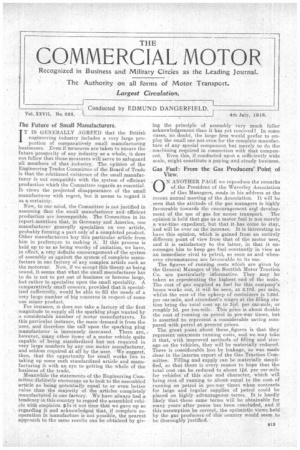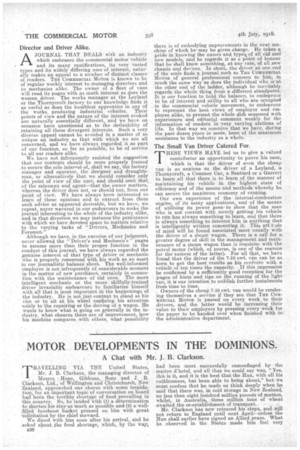fhe Future of Small Manufacturers.
Page 1

Page 2

If you've noticed an error in this article please click here to report it so we can fix it.
IT IS GENERALLY AGREED that the British engineering industry includes a. very large proportion of comparatively small manufacturing businesses. Even if measures are takento ensure the _ future prosperity of any industry a.s a whole, it does not follow that those measures will serve to safegnard all members of that industry. The opinion of the Engineering Trades Committee of the Board of Trade is that the edutinued existence of the small manufacturer is not compatible with the system of efficient production which the Committee regards as essential. It views the projected disappearance of the small manufacturer with regret, but it seems to regard it as a. certainty.
Now, to our mind, the Committee is not justified in assuming that the. small manufacturer and: efficient production are incompatible. The Committee in its report Meanwhile the statements of the Engineering Committee distinctly encourage us to look to the assembled article as being potentially equal to or even better value than the majority of. the articles completely manufactured. in one factory. We have always had a tendency in this country to regard the assembled vehi,cle with suspicion. 4Is it not time that we gave up so regarding it and acknowledged that, if complete cooperation in. Manufacture is not,' possible, the nearest approach to the same results can be obtained by giv ing the principle of assembly very much fuller acknowledgement than it has yet received ? In some cases, no doubt, the large firm would prefer to employ the small one not even for the complete manufacture of any special component but merely to do the machining required in connection -with that component. Even this, if conducted upon a sufficiently wide scale, might constitute a paying and steady business. Gas Fuel: From the Gas Producers' Point of View. -0 N ANOTHER PAGE we reproduce the remarks of.the President of the Waverley Association of Gas Managers, made in his address at the recent annual meeting of the Association. It will be , seen that the attitude of the gas managers is highly favourable towards the encouragement anil development of the use of gas for motor transport. The opinion is held that gas as a motor fuel is not merely .a. war-time expedient, but that it has come to stay, and will he ever on the increase. It is interesting to have this opinion, which is gained from an entirely different point of view from that of the motor user, and it is satisfactory to the latter, in that it encourages him to keep gas fuel constantly in 'view as an immediate rival to petrol, so soon as and whenever circumstances are favourable to its use. The figures of running costs which are given by the General Manager of the Scottish Motor Traction Co. aye 'partifularly informative. They may be taken as representing the highest end of the scale. The cost of gas supplied as fuel for this company's buses works out, it will be seen, at 2.17d. per mile, whilst the cost of the upkeep of containers is 1.25d. per car-mile, and attendant's wages at the filling station bring the total cost up to 314 per car-mile, or roughly Id. per ton-mile. This price is about double the cost of running an petrol in pre-war times, but is asserted to represent a considerable saving compared with petrol at present prices. The great point about theserfigures is that they represent maximum running costs, and we may take it that, with improved methods of filling and storage on the vehicles, they will be materially reduced. There is considerable loss by leakage, as was made clear in the interim report of the Gas Traction Committee... Filling and Supply can be materially sianplified, so that there is every reason to hope that the total cost can be reduced to about lid. per car-mile for vehicles of this size and character, which will bring cost of running to about equal to the cost of .running on petrol in pre-war times when contracts for large and regular supplies of petrol could be placed on highly advantageous terms. It is hardly likely that these Same terms will be ebtainable for many years after peace has been concluded, and if this assumption be correct, the optimistic Views held by the gas producerS of this country would seem to be thoroughly justified. • Director and Driver Alike. , AJOURNAL THAT DEALS with an industry which embraces the commercial motor vehicle • and its many ramifications, its very varied types and its widely differing uses of interest, naturally makes an appeal to a number of distinct classes of .readers. THE COMMERCIAL MOTOR is known to be of regular weekly interest to managing directors and to mechanics alike. The owner of a fleet of vans will read its pages with as much interest as does the woman driver. The works manager at the Leyland or the Thornyeroft factory to our knowledge finds it as useful as does the humblest apprentice in any of -. the works producing -industrial vehicles. Their points of view and the nature of the interest evoked are naturally essentially different, and we have on occasion been questioned as to the desirability of retaining all those divergent interests. Such a very diverse appeal cannot be avoided in a matter of so unique an industry as that with which we are all concerned, and we have always regarded it as part of our function, so far as possible, to be of service to all our readers alike. We have net infrequently resisted the suggestion that our contents should be more properly framed to secure the sole interest of, shall we say,.the factory Manager and operator, the designer and draughtsman, or alternatively that we should consider only the point. Of view .of the user, and should omit that of the salesman and agent—that the owner matters, • whereas the driver does not, or should not, from our point of view. We have always been interested to learn of these opinions and to extract from them such advice aS appeared desirable, but we have, we. repeat, never wavered in our endeavours to make the journal interesting to the whole of the industry alike, and in that direction we may instance-the persistence with which We have devoted space to matters relative to the varying tasks of "Drivers, Mechanics and Foremen." Although we have, in the exercise of our judgment., never allowed the "'Driver's and Mechanics " pages to assume more -than their proper function in the conduct of this journal, we have always regarded the genuine interest of that type of driver or .mechanic who is properly concerned with, his work as an asset in our journalistic balance sheet. The well-informed employee is not infrequently Of considerable moment in the matter of new purchases, certainly. in connection with the maintenance of old Ones. The more intelligent mechanic or the more -skilfully-trained driver invariably endeavours to familiarize himself with all that is most important in the happenings of the industry. He is not just content to stand at his vice or to sit at his wheel confining. his attention solely to the repairing er the driving of a wagon. He wants to know what is going on generally in the industry, what chances there are of improvement, how Ins machine compares with others, what possibility there is of embodying improvements in the next machine of which he' may be given charge. He takes a pride in knowing the names and types., of all old and new models, and he regards it as a point of honour that he shall know something, at any rate, of all new chassis and devices. In short, the driver at one end of the scale finds a journal such as Thu COMMERCIAL MOTOR of general professional concern to him, in much the same way as does the individual who iz'at the other end of the ladder, although he inevitably regards the whole thing from a different standpoint. It is our function to hold the balance, to endeavour to be of interest and utility to all who are occupied in the commercial vehicle movement, to endeavour to represent the best views of employer and employee alike, to present the whole dish seasoned with experiences and editorial comment weekly for the information .of readers m very varying stations, of life. In that way we conceive that we have, during the past dozen years Or more, been of the maximum assistance to the industry as a whole. The Small Van Driver Catered For. THESE VIEWS HAVE led us to give a, valued contributor an opportunity to prove his case, which is that the driver of even the cheap van is as anxious as the driver of a Leyland, a Thornycroft, a Commer Car, a Sentinel or a Garrett to learn all that there is to learn of the manner of maintaining his vehicle in the highest state of efficiency and of the means and methods whereby he can secure the maximum economy of running. _Our own experience of the internal-combustion engine, of its many applications, and of the means of utilising its power goes to show that the man who is not content with merely getting his vehicle to run has always something to i learn, and that there. is always something to interest hurl n anything that is intelligently written concerning it. This attitude of mind will be found associated most usually with the driver of a steam wagon. There is a call for a greater degree of skill in the management and maintenance of a steam wagon than is requisite with the petrol motor (which, of course, is one of the reasons for the -success of the latter). For all that, we have found that the driver of the 7-10 cwt. vain can be as keen to get the best results as his con frke with a vehiclb of ten times the capacity. , If this impression be confirmed by a sufficiently good reception for the pages of hints and tips on the running of the light van, it is our intention to publish further instalments from time to time. , .Owners of the cheap 7-10 cwt. van would be rendering themselves a service if they see that TEE COMMERCIAL MOTOR is passed on every week to their drivers, and the latter would be increasing their value to their employers by pressing every week for the paper to be handed over when finished with in the administrative department.






















